Essay on the Epidemiologic Approach: Strengths and Limitations
VerifiedAdded on 2020/03/13
|5
|1055
|155
Essay
AI Summary
This essay provides an overview of the epidemiologic approach, emphasizing its significance in understanding disease causation within the public health sector. It highlights the strengths of this approach, such as its ability to study disease patterns, identify risk factors, and inform healthcare decisions, leading to improved healthcare delivery and preventive measures. The essay also acknowledges the limitations, including differing scientific definitions and potential for varying results due to assumptions. Furthermore, it discusses the importance of epidemiology in disease surveillance, evaluation of interventions, and understanding the causes and effects of diseases to develop effective strategies. The essay concludes by underscoring the crucial role of epidemiology in addressing emerging health challenges, such as those posed by urbanization and lifestyle changes, and its contribution to reducing disease burden and mortality.
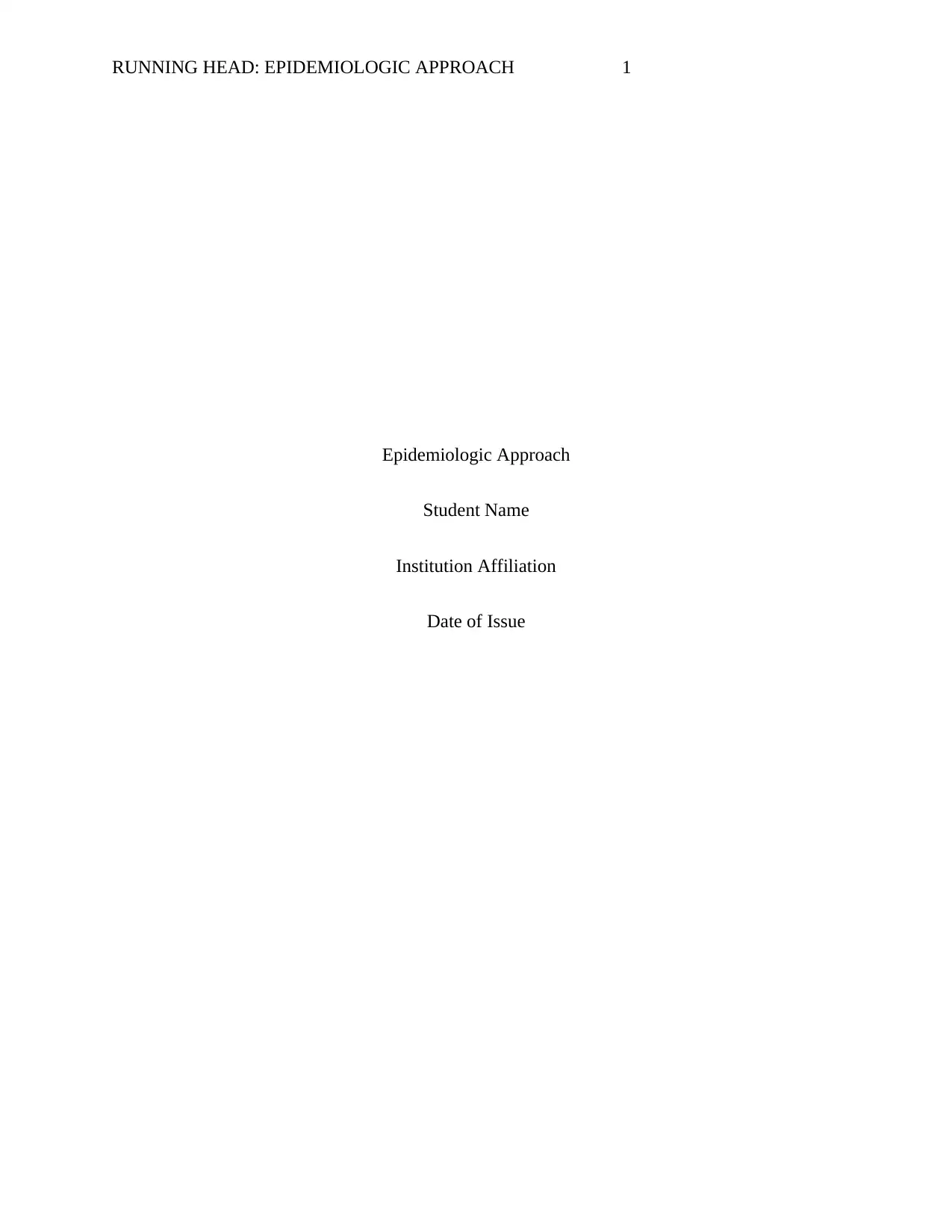
RUNNING HEAD: EPIDEMIOLOGIC APPROACH 1
Epidemiologic Approach
Student Name
Institution Affiliation
Date of Issue
Epidemiologic Approach
Student Name
Institution Affiliation
Date of Issue
Paraphrase This Document
Need a fresh take? Get an instant paraphrase of this document with our AI Paraphraser
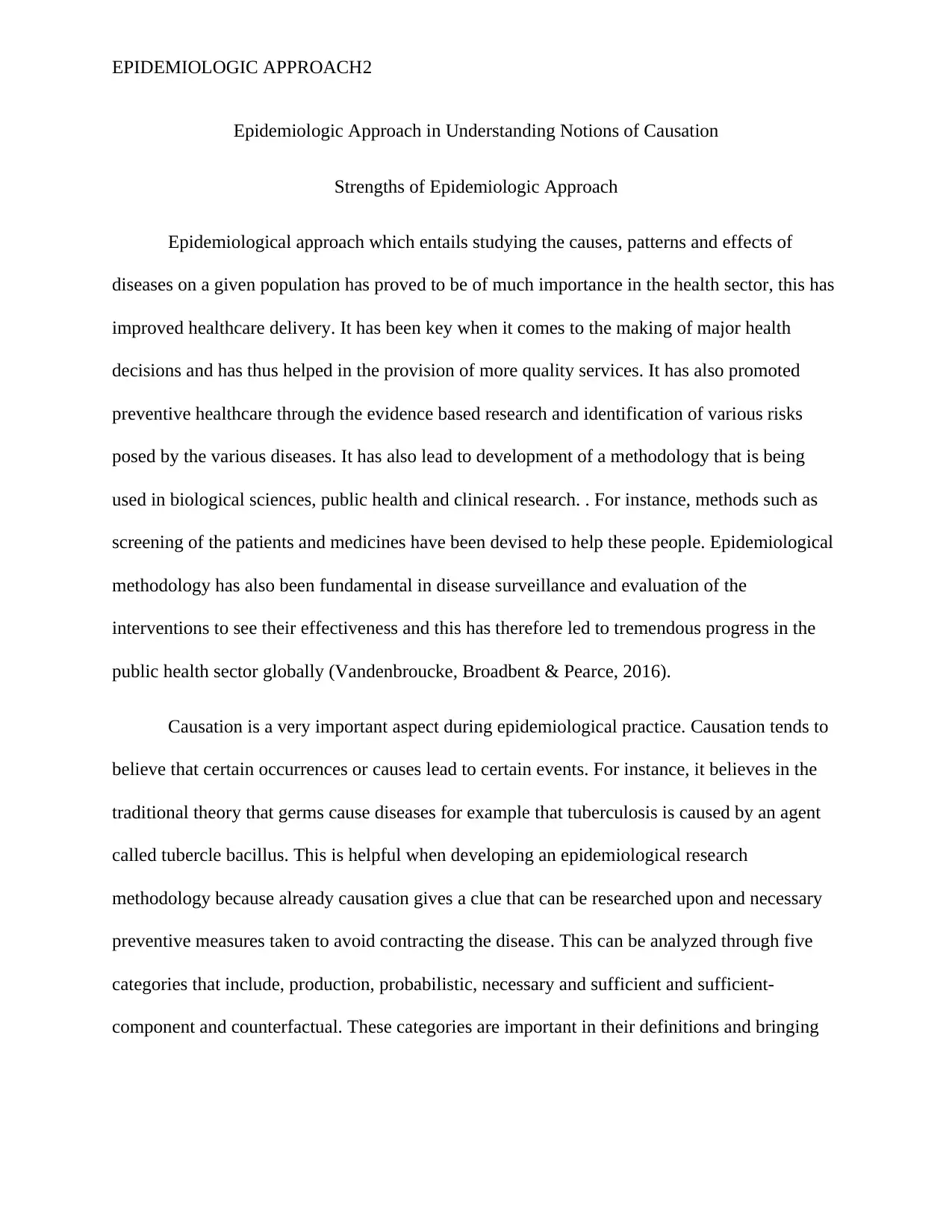
EPIDEMIOLOGIC APPROACH2
Epidemiologic Approach in Understanding Notions of Causation
Strengths of Epidemiologic Approach
Epidemiological approach which entails studying the causes, patterns and effects of
diseases on a given population has proved to be of much importance in the health sector, this has
improved healthcare delivery. It has been key when it comes to the making of major health
decisions and has thus helped in the provision of more quality services. It has also promoted
preventive healthcare through the evidence based research and identification of various risks
posed by the various diseases. It has also lead to development of a methodology that is being
used in biological sciences, public health and clinical research. . For instance, methods such as
screening of the patients and medicines have been devised to help these people. Epidemiological
methodology has also been fundamental in disease surveillance and evaluation of the
interventions to see their effectiveness and this has therefore led to tremendous progress in the
public health sector globally (Vandenbroucke, Broadbent & Pearce, 2016).
Causation is a very important aspect during epidemiological practice. Causation tends to
believe that certain occurrences or causes lead to certain events. For instance, it believes in the
traditional theory that germs cause diseases for example that tuberculosis is caused by an agent
called tubercle bacillus. This is helpful when developing an epidemiological research
methodology because already causation gives a clue that can be researched upon and necessary
preventive measures taken to avoid contracting the disease. This can be analyzed through five
categories that include, production, probabilistic, necessary and sufficient and sufficient-
component and counterfactual. These categories are important in their definitions and bringing
Epidemiologic Approach in Understanding Notions of Causation
Strengths of Epidemiologic Approach
Epidemiological approach which entails studying the causes, patterns and effects of
diseases on a given population has proved to be of much importance in the health sector, this has
improved healthcare delivery. It has been key when it comes to the making of major health
decisions and has thus helped in the provision of more quality services. It has also promoted
preventive healthcare through the evidence based research and identification of various risks
posed by the various diseases. It has also lead to development of a methodology that is being
used in biological sciences, public health and clinical research. . For instance, methods such as
screening of the patients and medicines have been devised to help these people. Epidemiological
methodology has also been fundamental in disease surveillance and evaluation of the
interventions to see their effectiveness and this has therefore led to tremendous progress in the
public health sector globally (Vandenbroucke, Broadbent & Pearce, 2016).
Causation is a very important aspect during epidemiological practice. Causation tends to
believe that certain occurrences or causes lead to certain events. For instance, it believes in the
traditional theory that germs cause diseases for example that tuberculosis is caused by an agent
called tubercle bacillus. This is helpful when developing an epidemiological research
methodology because already causation gives a clue that can be researched upon and necessary
preventive measures taken to avoid contracting the disease. This can be analyzed through five
categories that include, production, probabilistic, necessary and sufficient and sufficient-
component and counterfactual. These categories are important in their definitions and bringing
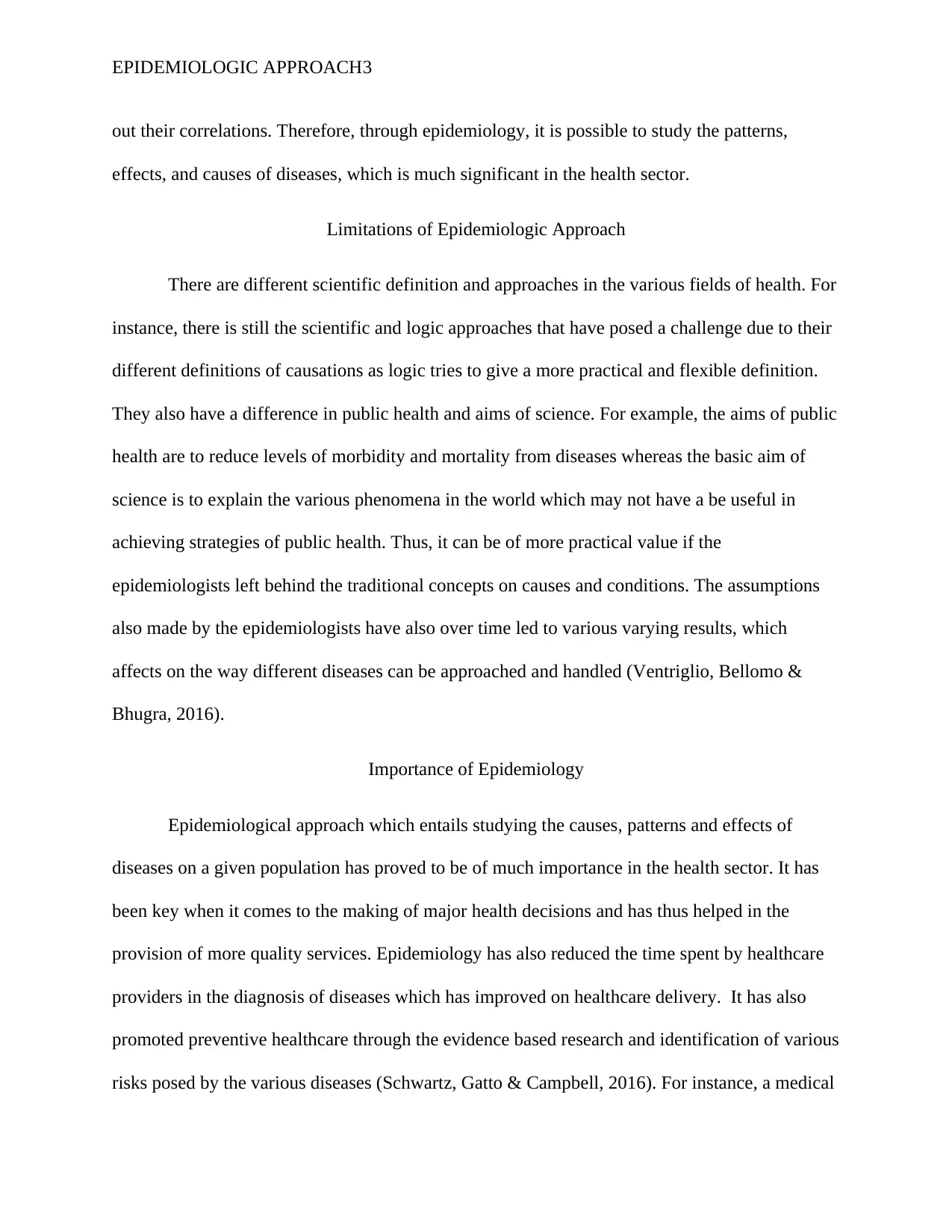
EPIDEMIOLOGIC APPROACH3
out their correlations. Therefore, through epidemiology, it is possible to study the patterns,
effects, and causes of diseases, which is much significant in the health sector.
Limitations of Epidemiologic Approach
There are different scientific definition and approaches in the various fields of health. For
instance, there is still the scientific and logic approaches that have posed a challenge due to their
different definitions of causations as logic tries to give a more practical and flexible definition.
They also have a difference in public health and aims of science. For example, the aims of public
health are to reduce levels of morbidity and mortality from diseases whereas the basic aim of
science is to explain the various phenomena in the world which may not have a be useful in
achieving strategies of public health. Thus, it can be of more practical value if the
epidemiologists left behind the traditional concepts on causes and conditions. The assumptions
also made by the epidemiologists have also over time led to various varying results, which
affects on the way different diseases can be approached and handled (Ventriglio, Bellomo &
Bhugra, 2016).
Importance of Epidemiology
Epidemiological approach which entails studying the causes, patterns and effects of
diseases on a given population has proved to be of much importance in the health sector. It has
been key when it comes to the making of major health decisions and has thus helped in the
provision of more quality services. Epidemiology has also reduced the time spent by healthcare
providers in the diagnosis of diseases which has improved on healthcare delivery. It has also
promoted preventive healthcare through the evidence based research and identification of various
risks posed by the various diseases (Schwartz, Gatto & Campbell, 2016). For instance, a medical
out their correlations. Therefore, through epidemiology, it is possible to study the patterns,
effects, and causes of diseases, which is much significant in the health sector.
Limitations of Epidemiologic Approach
There are different scientific definition and approaches in the various fields of health. For
instance, there is still the scientific and logic approaches that have posed a challenge due to their
different definitions of causations as logic tries to give a more practical and flexible definition.
They also have a difference in public health and aims of science. For example, the aims of public
health are to reduce levels of morbidity and mortality from diseases whereas the basic aim of
science is to explain the various phenomena in the world which may not have a be useful in
achieving strategies of public health. Thus, it can be of more practical value if the
epidemiologists left behind the traditional concepts on causes and conditions. The assumptions
also made by the epidemiologists have also over time led to various varying results, which
affects on the way different diseases can be approached and handled (Ventriglio, Bellomo &
Bhugra, 2016).
Importance of Epidemiology
Epidemiological approach which entails studying the causes, patterns and effects of
diseases on a given population has proved to be of much importance in the health sector. It has
been key when it comes to the making of major health decisions and has thus helped in the
provision of more quality services. Epidemiology has also reduced the time spent by healthcare
providers in the diagnosis of diseases which has improved on healthcare delivery. It has also
promoted preventive healthcare through the evidence based research and identification of various
risks posed by the various diseases (Schwartz, Gatto & Campbell, 2016). For instance, a medical
⊘ This is a preview!⊘
Do you want full access?
Subscribe today to unlock all pages.

Trusted by 1+ million students worldwide
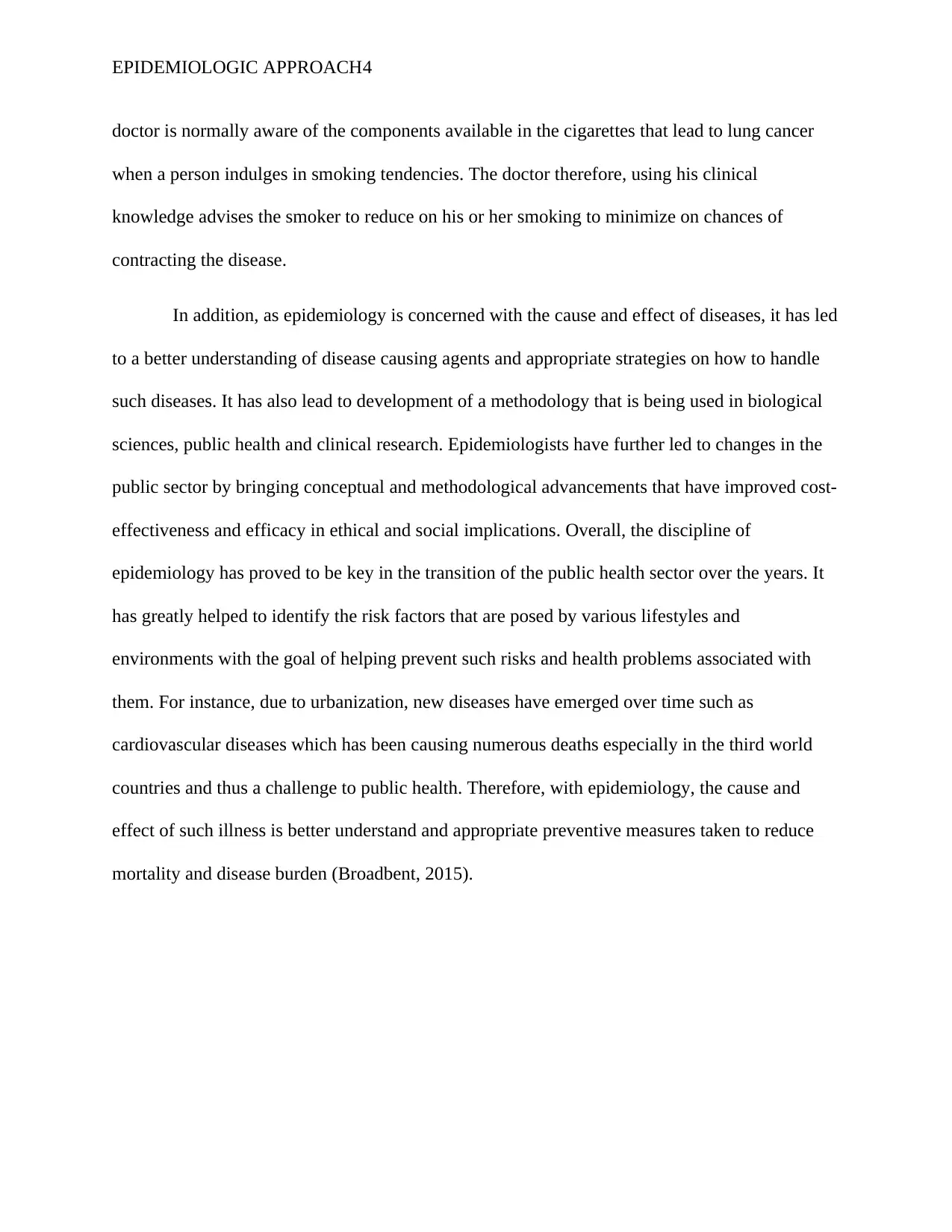
EPIDEMIOLOGIC APPROACH4
doctor is normally aware of the components available in the cigarettes that lead to lung cancer
when a person indulges in smoking tendencies. The doctor therefore, using his clinical
knowledge advises the smoker to reduce on his or her smoking to minimize on chances of
contracting the disease.
In addition, as epidemiology is concerned with the cause and effect of diseases, it has led
to a better understanding of disease causing agents and appropriate strategies on how to handle
such diseases. It has also lead to development of a methodology that is being used in biological
sciences, public health and clinical research. Epidemiologists have further led to changes in the
public sector by bringing conceptual and methodological advancements that have improved cost-
effectiveness and efficacy in ethical and social implications. Overall, the discipline of
epidemiology has proved to be key in the transition of the public health sector over the years. It
has greatly helped to identify the risk factors that are posed by various lifestyles and
environments with the goal of helping prevent such risks and health problems associated with
them. For instance, due to urbanization, new diseases have emerged over time such as
cardiovascular diseases which has been causing numerous deaths especially in the third world
countries and thus a challenge to public health. Therefore, with epidemiology, the cause and
effect of such illness is better understand and appropriate preventive measures taken to reduce
mortality and disease burden (Broadbent, 2015).
doctor is normally aware of the components available in the cigarettes that lead to lung cancer
when a person indulges in smoking tendencies. The doctor therefore, using his clinical
knowledge advises the smoker to reduce on his or her smoking to minimize on chances of
contracting the disease.
In addition, as epidemiology is concerned with the cause and effect of diseases, it has led
to a better understanding of disease causing agents and appropriate strategies on how to handle
such diseases. It has also lead to development of a methodology that is being used in biological
sciences, public health and clinical research. Epidemiologists have further led to changes in the
public sector by bringing conceptual and methodological advancements that have improved cost-
effectiveness and efficacy in ethical and social implications. Overall, the discipline of
epidemiology has proved to be key in the transition of the public health sector over the years. It
has greatly helped to identify the risk factors that are posed by various lifestyles and
environments with the goal of helping prevent such risks and health problems associated with
them. For instance, due to urbanization, new diseases have emerged over time such as
cardiovascular diseases which has been causing numerous deaths especially in the third world
countries and thus a challenge to public health. Therefore, with epidemiology, the cause and
effect of such illness is better understand and appropriate preventive measures taken to reduce
mortality and disease burden (Broadbent, 2015).
Paraphrase This Document
Need a fresh take? Get an instant paraphrase of this document with our AI Paraphraser
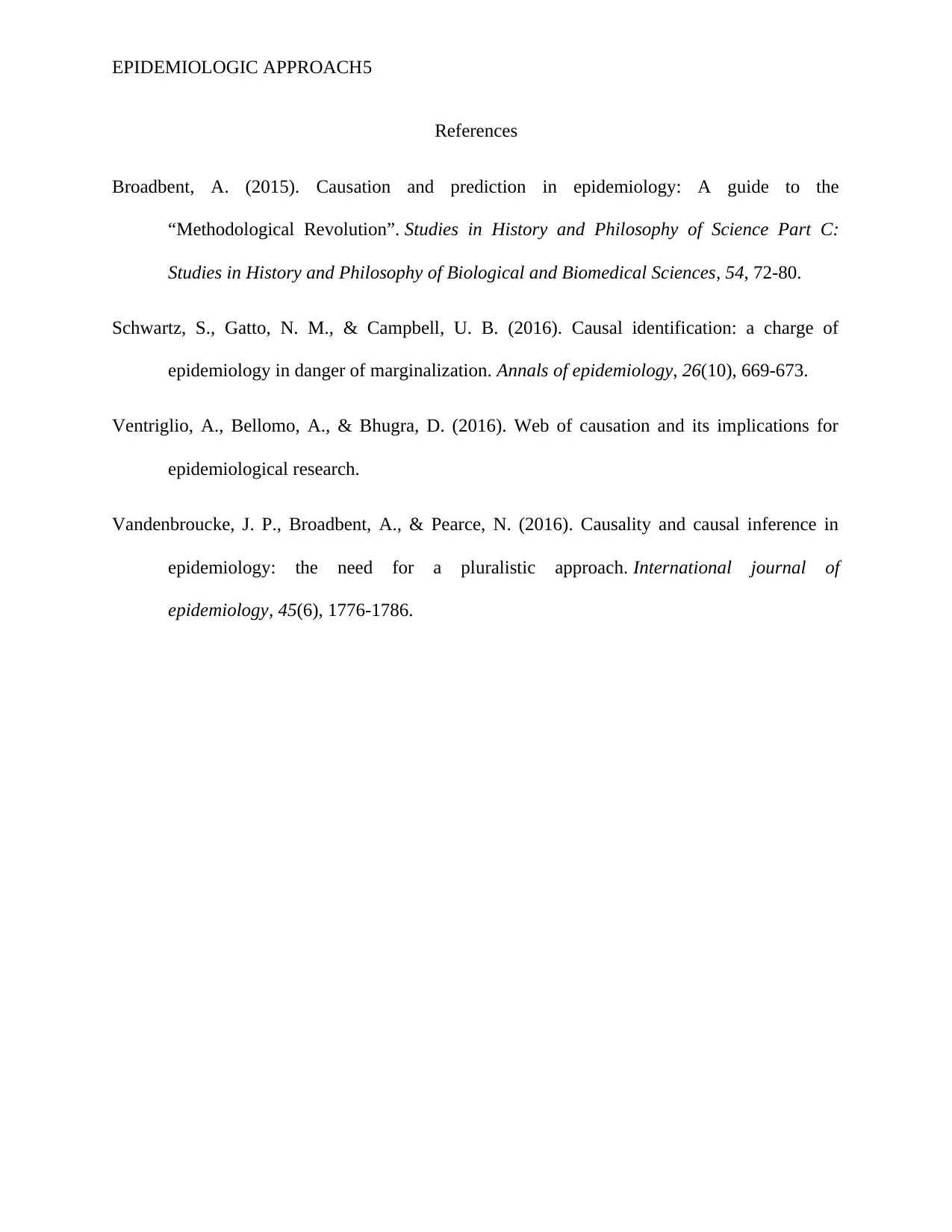
EPIDEMIOLOGIC APPROACH5
References
Broadbent, A. (2015). Causation and prediction in epidemiology: A guide to the
“Methodological Revolution”. Studies in History and Philosophy of Science Part C:
Studies in History and Philosophy of Biological and Biomedical Sciences, 54, 72-80.
Schwartz, S., Gatto, N. M., & Campbell, U. B. (2016). Causal identification: a charge of
epidemiology in danger of marginalization. Annals of epidemiology, 26(10), 669-673.
Ventriglio, A., Bellomo, A., & Bhugra, D. (2016). Web of causation and its implications for
epidemiological research.
Vandenbroucke, J. P., Broadbent, A., & Pearce, N. (2016). Causality and causal inference in
epidemiology: the need for a pluralistic approach. International journal of
epidemiology, 45(6), 1776-1786.
References
Broadbent, A. (2015). Causation and prediction in epidemiology: A guide to the
“Methodological Revolution”. Studies in History and Philosophy of Science Part C:
Studies in History and Philosophy of Biological and Biomedical Sciences, 54, 72-80.
Schwartz, S., Gatto, N. M., & Campbell, U. B. (2016). Causal identification: a charge of
epidemiology in danger of marginalization. Annals of epidemiology, 26(10), 669-673.
Ventriglio, A., Bellomo, A., & Bhugra, D. (2016). Web of causation and its implications for
epidemiological research.
Vandenbroucke, J. P., Broadbent, A., & Pearce, N. (2016). Causality and causal inference in
epidemiology: the need for a pluralistic approach. International journal of
epidemiology, 45(6), 1776-1786.
1 out of 5
Related Documents
Your All-in-One AI-Powered Toolkit for Academic Success.
+13062052269
info@desklib.com
Available 24*7 on WhatsApp / Email
![[object Object]](/_next/static/media/star-bottom.7253800d.svg)
Unlock your academic potential
Copyright © 2020–2025 A2Z Services. All Rights Reserved. Developed and managed by ZUCOL.




